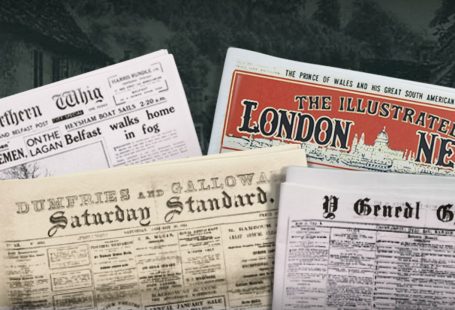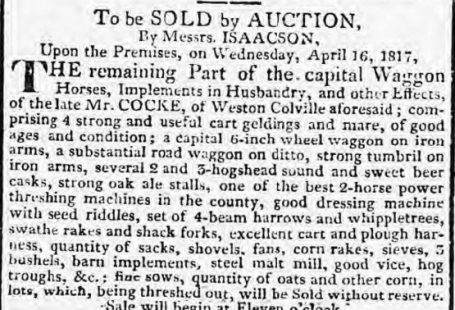This week the presses have gone into overdrive to bring you half a million brand new newspaper pages, or 505,430 brand new pages to be exact. We’ve added ten brand new newspapers from across the world, from Guyana and Antigua, as we continue to tell the often confronting story of the British Empire. Meanwhile, we’ve also added new newspapers from England and from Wales, whilst we’ve made updates to a staggering 75 of our existing titles.
So read on to discover more about all of our new and updated titles of the week, and to also learn about Quamina Gladstone (1778-1823), an enslaved person who is a national hero in Guyana thanks to his part in the Demerara Rebellion of 1823, which was one of the largest revolts of enslaved people in the British colonies before the practice of enslavement was abolished.
Register now and explore the Archive
The first of our new titles this week is the Official Gazette of British Guiana, which was published in Georgetown, in what was known as British Guiana, from 1851. The official mouthpiece of the colonial British government, the gazette was a publication authorised to publish public notices, and was one of many British colonial gazettes published across the world.
On the northern coast of South America, British Guiana was first settled by Dutch colonialists in the seventeenth century. In 1796 the British seized control of the country, although official control was not formally ceded by the Dutch until 1815. British Guiana finally became independent from Britain on 26 May 1966, becoming known as Guyana, and that was when publication of the Official Gazette of British Guiana also ceased.
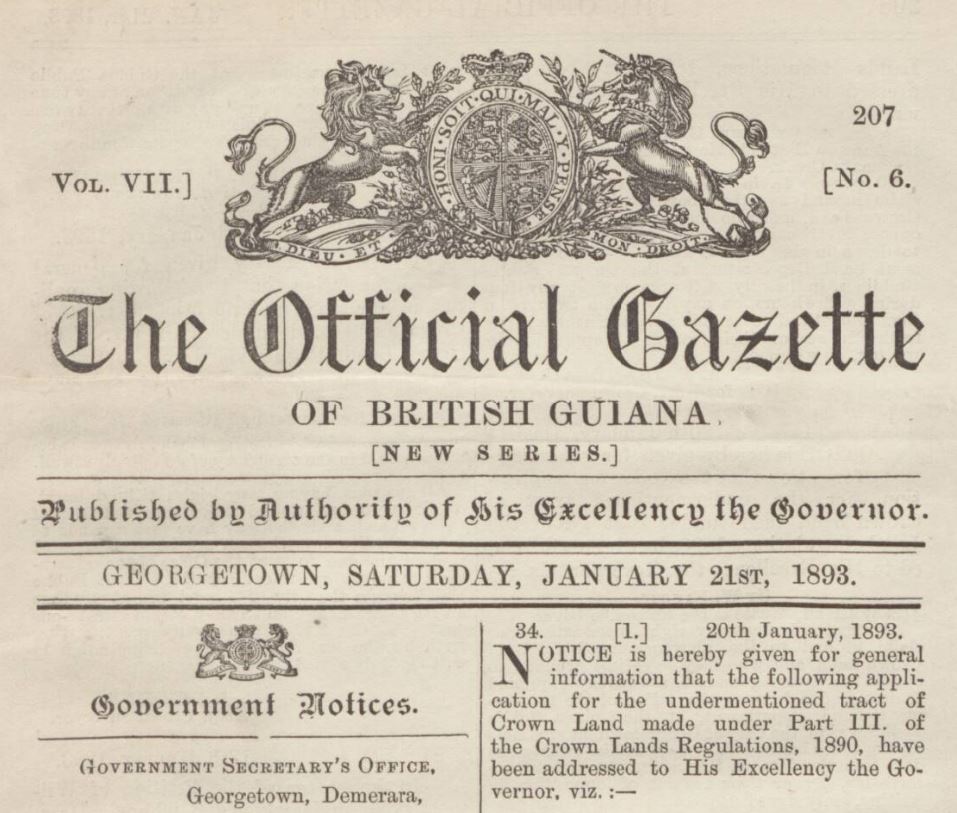
Appearing twice a week, on Saturdays and Wednesdays, the Official Gazette of British Guiana was usually over twenty pages long. A sort of handbook to the former British colony, this publication is incredibly name rich. It contains lists of those involved in the mechanics of colonialism, from names of civil servants in British Guiana, to lists of those involved in mining operations, or the purchase of property.
So within the pages of the Official Gazette of British Guiana you can find a range of ‘Government Notices from the Government Secretary’s Office,’ which would feature announcements of government appointments, details of leaves of absences, and applications to license Crown Land. Meanwhile, the publication would also print militia notices, judicial notices, and details about immigration. Throughout the nineteenth century and into the twentieth century indentured Indian immigrants came to Guyana, and the Official Gazette provides an insight into the mechanics of their arrival, for example detailing the plantations to which they were sent.
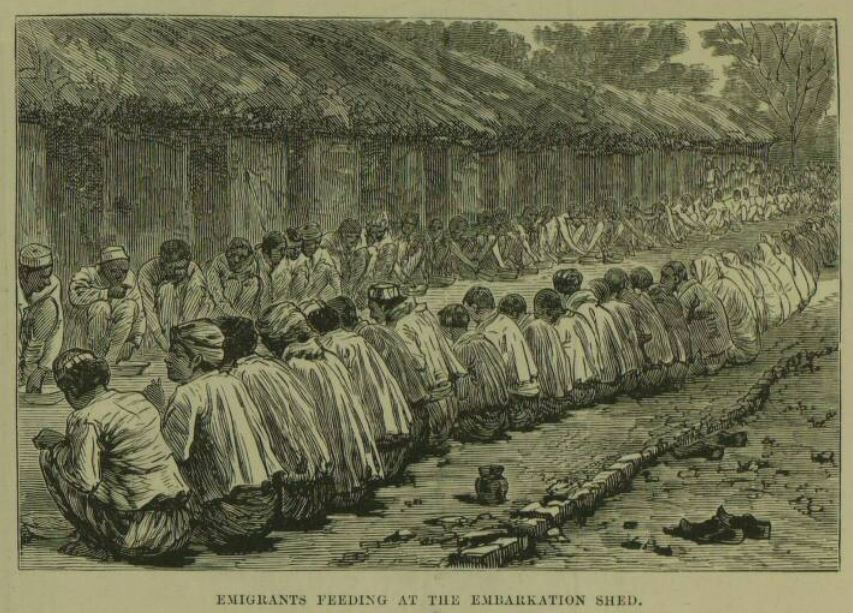
The Official Gazette of British Guiana also provides a sobering look at the colonial plundering of Guyana’s natural resources. It contains extensive details about the mining operations in the colony, whilst also detailing the exports, or ‘transportation of goods,’ from the colony’s plantations.
Furthermore, the pages of the Official Gazette of British Guiana also contain news of deaths in the colony, looking at how the estates of the deceased were to be distributed. The publication also contained a general overview of the health of the people in British Guiana, with a weekly look at mortality rates in the colony, with fever, dysentery, and influenza all contributing to often high mortality rates.
We have another official government gazette joining us this week, which hails from Antigua, and is the Leeward Islands Gazette. Published in Saint John’s, the Antiguan capital, this publication was the government gazette for the Leeward Islands from 1872, covering the likes of Antigua and Barbuda, Saint Kitts and Nevis, and the Virgin Islands.

In very much the same vein as the Official Gazette of British Guiana, the Leeward Islands Gazette contained a range of legal announcements, including a ‘Registry of Titles’ for property across the islands. Usually filling two to eight pages, this publication also featured a ‘Meteorological Register’ and news from the Supreme Court of the Leeward Islands. This title was eventually replaced by the Antigua, Montserrat and Virgin Islands Official Gazette.
Our next two new titles of the week hail from Wales, the first of which is the Bridgend & Ogwr Herald & Post. This free weekly tabloid was established in 1984, and was delivered to homes in and around the town of Bridgend, which lies partway between Cardiff and Swansea. Appearing every Thursday, the title was renamed the Bridgend & Ogwr Post in 1994, Ogwr being a borough in Mid Glamorgan from 1974 to 1996, before simply becoming The Post from 1995 onwards. The final edition of The Post appeared in 2008, with the Glamorgan Gazette continuing to serve the area.

Our second Welsh title of the week comes from the north of the country, and we’re delighted to welcome the Rhyl, Prestatyn Visitor to our collection of Welsh newspapers. Published in the seaside town of Rhyl, this weekly freesheet tabloid was distributed to homes in and around Rhyl and Prestatyn, in Denbighshire. In 2008, this title was merged with the Denbighshire Visitor, in an editorial rearrangement that also witnessed the demise of the Abergele & St Asaph Visitor.
We are officially at the halfway mark of our new newspapers of the week, and our final five all hail from England, covering the north, the east, the west and the south of the country. And it’s in the North East we start, with the introduction of the North Tyneside Herald & Post to our collection. Founded in 1991 as a weekly companion to the evening tabloid title the Newcastle Evening Chronicle, the North Tyneside Herald & Post was a freesheet that was distributed to the towns of North Shields, Longbenton, Tynemouth, Whitley Bay and Wallsend. Relaunched as the North Tyneside Chronicle eXTRA in 2007, the final edition of this title appeared two years later in 2009.

We travel a little further south now to welcome the West Hull Advertiser to The Archive. Founded in 1995 to cover the news from the western half of the city of Kingston upon Hull as a sub-edition of the Hull Advertiser, the title merged with the East Hull & Holderness Advertiser at the end of June 2011 to become the Hull & East Riding Advertiser.
We move to the Midlands now to introduce Leicestershire title the Coalville Mail to our collection. The Coalville Mail was founded in 1990 and was a weekly tabloid freesheet, which was delivered to towns in north-western Leicestershire, including Whitwick, Ibstock, and of course, Coalville. A former mining town, Coalville was very much the product of the industrial revolution, and its new nineties newspaper, the Coalville Mail, was a companion to the county daily, the Leicester Daily Mercury.

It’s south again we go now, and this time our destination is Essex, which is home to our next new title of the week, the Billericay Gazette. This ongoing title, now known as the Billericay & Wickford Gazette, appears every Wednesday in the commuter town of Billericay, covering all the local news from the town and the surrounding area.
Our penultimate new title of the week is Buckinghamshire’s Beaconsfield Advertiser, which was established way back in 1837 as part of the Buckinghamshire Advertiser. Incorporating towns like Chalfont St Giles, Chalfont St Peter and Gerrards Cross in south Buckinghamshire, the Beaconsfield Advertiser appears every Wednesday in the market town, which lies near the Chiltern Hills.

Our final new title of the week is from Devon, and it is the Exeter Leader. Launched in 1984 as a weekly freesheet tabloid, the Exeter Leader was a companion newspaper to the Express & Echo, the two newspapers sharing editorial offices in Exeter. In 1990 the title, which was delivered to homes across the city of Exeter, the historic county town of Devon, became known simply as The Leader. In 1998 it once again became known as the Exeter Leader, before becoming the Exeter Times in 2005. Appearing every Thursday, the newspaper ceased publication in September 2011.

That may be it from our terrific ten new newspapers this week, but we have a glut of updated newspapers for you to feast on, with updates to 75 of our existing titles. This week again sees extensive updates to the Bristol Evening Post, with over 100,000 pages being added to this important regional title, whilst we have added over 50,000 pages to the Hull Daily Mail. Other significant updates of the week are to the Aldershot News, the Torbay Express and South Devon Echo, and the Scunthorpe Evening Telegraph.
We’ve also added new pages to our Welsh and Scottish newspaper titles, with updates to the likes of Herald Cymraeg and the Dumfries and Galloway Standard. We’ve not neglected our specialist titles this week either, with updates to sporting title the Football Post (Nottingham). Meanwhile, we’re delighted to have added more pages to light entertainment weekly and popular 1950s title Reveille.
Quamina Gladstone and the Demerara Rebellion of 1823
In August 1823, enslaved persons rose up in the Demerara-Essequibo region of what is now Guyana, in protest against their poor treatment, and the mistaken belief that Parliament had emancipated the enslaved population, but the colonial rulers were withholding their freedom.
Instigated mainly by Jack Gladstone, who was enslaved at the ‘Success’ plantation, and involving his father Quamina, the peaceful rebellion was brutally quashed by governor John Murray, with 100 to 250 enslaved persons being killed. Implicated too was English missionary John Smith, who was sentenced to death for his role in the rebellion, but he died before the sentence and news of his reprieve could be carried out. Smith became known as a martyr for the abolitionist cause, but it was Quamina, who was killed during the rebellion, who became a national martyr in Guyana, with streets named after him.

Quamina was of African descent, from modern day Ghana, and during his enslavement, he had learned to read and to write, and had converted to Christianity. Searching the pages of the Official Gazette of British Guiana, we see the name ‘Quamina’ used repeatedly, many decades after his death. We see, for example, how a river creek in Berbice Judicial District was named after him – the ‘opposite mouth of Quamina Creek, right bank Berbice river’ – this from the Official Gazette in January 1913.
And, unusually for enslaved persons of the time, Quamina’s name was actually reported upon in the contemporary press, at the time of the rebellion, in the early 1820s. As news travelled slowly, the national press back in Britain picked up the story in the spring of 1824, and there was a general tone of outrage that underpinned the reporting on the Demerara Rebellion, as support for the abolition movement grew.
This is from the Westmorland Gazette, 6 March 1824:
Of the objects of those who promoted that disturbance little or nothing is yet publicly known; but it is known that above 1000 slaves took part in it; and that although they did not kill a single person, yet several hundreds of the offenders afterwards perished by the sword or the gibbet!

The article goes on to report how John Smith, the missionary, was arrested, and brought before a court martial. The charges against him included that he had provoked ‘discontent and dissatisfaction’ in the minds of the enslaved population he lived amongst, against the ‘masters, managers, and overseers…contrary to his allegiance, and against the peace of our Sovereign Lord the King, his Crown and dignity.’
The other charge revolved around his relationship with Quamina, who was father to Jack Gladstone, who was one of the principal agitators of the rebellion. The Westmorland Gazette narrates this particular charge. Please do be aware that this extract uses outmoded language, such that we would be considered offensive today:
For that he that said John Smith, having, about the 17th day of August, and (at divers other days and times) one day theretofore preceding, advised, consulted and corresponded with a certain Negro, named Quamina, touching and concerning a certain revolt and rebellion of the Negro Slaves within these Colonies of Demerara and Essequibo; and further after such revolt and rebellion had actually commenced and was in a course of prosecution, he, the said John Smith, did further aid and assist in such a rebellion, by advising, consulting, and corresponding, touching the same with the said Negro Quamina – to wit, on the (19th and) 20th of August last – he, the said John Smith, then well knowing such revolt and rebellion to be in progress, and the said Negro, Quamina, to be an insurgent engaged therein.

A few weeks later, and Caribbean newspaper the Barbadian on 9 April 1824 contained testimony from John Smith himself, from his trial. Smith addressed Quamina’s role in the rebellion, which was deemed to be an important one by authorities, but was actually minimal. Quamina counselled a non-violent approach, and was indeed arrested before the rebellion broke out. Freed, however, by those engaged in the rebellion, Quamina never once took up arms, and remained at large for several weeks. The authorities were convinced that he was the ringleader, and he was shot in the fields of Chateau Margo after refusing to surrender to British soldiers.
Regarding Quamina’s role in the rebellion, John Smith testified:
I maintain that it has not been proved that Quamina was a rebel. I maintain that to establish this, conviction was necessary; even when he was shot, he had no arms nor had any one that was with him according to the testimony of Captain McTurk, and surely implicit reliance cannot be placed upon evidence of such witnesses as the negroes brought against me.
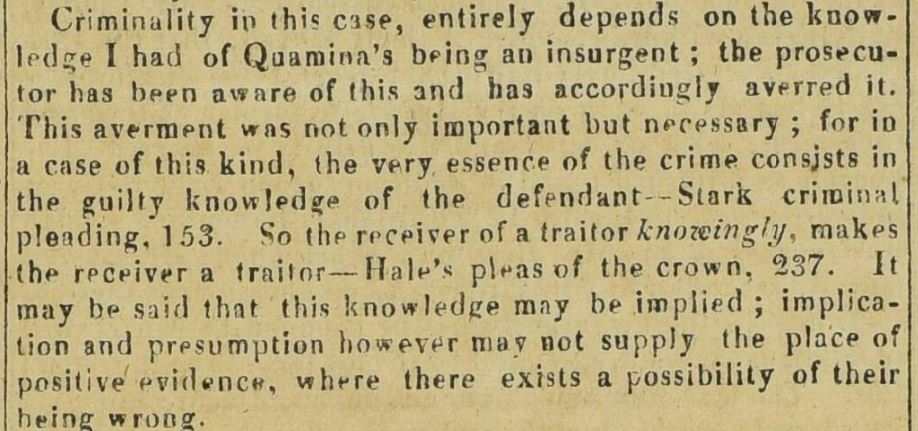
Smith continued:
The man was never tried, and however strong the presumption may be against him, still there is no saying, that had he been tried, he might upon cross-examination of the witnesses against him, have so explained his conduct as to have shewn that he was innocent; he might have been carried aback by force, for any thing that appears to the contrary. It is contrary to the first principal of English law, to believe a man guilty until he shall have been proved to be so – that is, fairly tried and convicted.
Smith’s words were largely reported on by the press of the day, and his subsequent death made him something of a martyr for the abolition movement. But the enslaved persons that day who stood up against British colonial rule should also be remembered, like Quamina, and his son, Jack, whose bravery is remembered in Guyana, and whose bravery we mark this week as part of Black History Month.
For more on uncovering Black history at The Archive, read our special blogs here.
New Titles
Title |
Year Range |
| Beaconsfield Advertiser | 1994 |
| Billericay Gazette | 1996 |
| Bridgend & Ogwr Herald & Post | 1995 |
| Coalville Mail | 1995 |
| Exeter Leader | 1994 |
| Leeward Islands Gazette | 1893 |
| North Tyneside herald & post | 1996 |
| Official Gazette of British Guiana | 1893-1919 |
| Rhyl, Prestatyn Visitor | 1995 |
| West Hull Advertiser | 1995 |
Updated Titles
This week we have updated 75 of our existing titles.
You can learn more about each of the titles we add to every week by clicking on their names. On each paper’s title page, you can read a FREE sample issue, learn more about our current holdings, and our plans for digitisation.
You can keep up to date with all the latest additions by visiting the recently added page. You can even look ahead to see what we’re going to add tomorrow.




